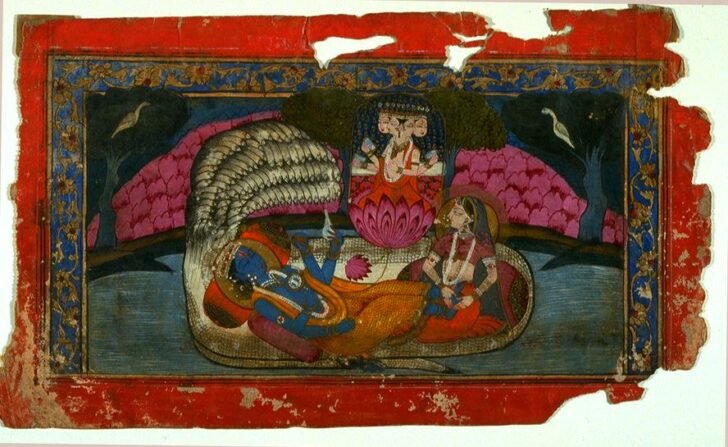Vishnu on Ananta
Indian

Description
March 28, 2009
In one version of the Hindu origin myth, Brahma the Creator emerges from Vishnu’s navel, while Vishnu as Narayana reclines on the coiled body of an enormous serpent, Ananta (meaning “endless”). In paintings depicting the event, Vishnu’s consort Lakshmi rubs his feet while Brahma rises from the bud of a lotus. Most often, the source of cosmic origination—Vishnu’s navel—occupies the center of the composition.
This painting was made in the northern Indian region of Kashmir in the eighteenth century, by which time illustrations of religious subjects incorporated many features of royal painting. Note that Krishna and Radha relax on richly embroidered bolsters wearing contemporary jeweled armbands and necklaces. Artists developed their skill at rendering these minute details in portrayals of courtly events, at which nobles and courtiers donned elaborate textiles and jewelry.
(Label for UMMA South and Southeast Asia Gallery Opening Rotation, March 2009); Anonymous
Vishnu on Ananta
India, Kashmir
18th century
Opaque watercolor and gold on paper
Gift of Professor Walter M. and Nesta R. Spink, 1985/1.132
Subject Matter:
In one version of the Hindu origin myth, Brahma the Creator emerges from Vishnu’s navel, while Vishnu as Narayana reclines on the coiled body of an enormous serpent, Ananta (literally meaning “endless”). In paintings depicting the event, Vishnu’s consort Lakshmi rubs his feet while Brahma rises from the bud of a lotus. Most often, the source of cosmic origination—Vishnu’s navel—occupies the center of the composition.
This painting was made in the northern Indian region of Kashmir in the 18th century, by which time illustrations of religious subjects incorporated many features of royal painting. Note that Krishna and Radha relax on richly embroidered bolsters wearing contemporary jeweled armbands and necklaces. Artists had developed skills rendering these minute details in portrayals of courtly events, at which nobles and courtiers donned elaborate textiles and jewelry.
Physical Description:
Two central figures are on a large snake; one a reclining blue-skinned figure, the other a seated female to his right. The female figure is holding his feet. A lotus flower grows out of his navel and from the lotus, a four-headed figure. The background is a landscape.
Usage Rights:
If you are interested in using an image for a publication, please visit https://umma.umich.edu/request-image/ for more information and to fill out the online Image Rights and Reproductions Request Form.